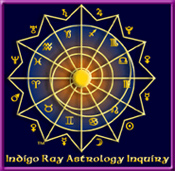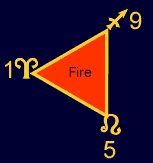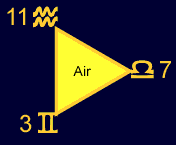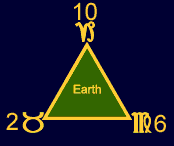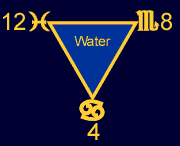
|
|
- Sabian
Symbols
- A
system of working with individual degree meanings that were
first created by Marc Edmund Jones
with the help of psychic, Elsie Wheeler, and then modified by
Dane Rudhyar.
Recommended websites are: http://www.sabiansymbols.com
and http://www.sabian.org
|
- Sextile
- An
aspect
with a difference of 60 degrees. A generally helpful and 'positive'
aspect.
|
- Sidereal
Time
- Time
in relations to the fixed
stars, rather than clock time.
|
- Sidereal
Zodiac
- A
Zodiac based on the placement of the stars, not the Vernal Equinox.
It is used in Eastern, Hindu, or Vedic Astrology.
|
- Signs
- Twelve
30° segments of the ecliptic which can be defined tropically
or sidereally. Not the same
as constellations,
which are unequal in degree star groups that can be seen beyond
the general path of the ecliptic.
The classical Greeks named the Tropical Signs for the constellations
that, at that time, approximately coincided. Due to the Precession
of the Equinoxes, the Signs and the Constellations no longer
coincide. See also Zodiac.
|
- Soft
Aspects or Easy aspects
- A
harmonious and easily flowing aspect such as Conjunct,
Trine
or Sextile
and Quintile
|
- Solar
Return
- A
horoscope cast for the moment when the Sun returns to the exact
degree/minute/second of celestial longitude which it occupied
at birth. This moment will be within a day or two of one's birthday.
The horoscope is considered symbolic of the coming year.
|
- South
Node
- see
Moon
Nodes
|
- Square
- Aspect
with a difference of 90 degrees. Generally causes difficulty and
discord.
|
- Station
- The
point at which a planet appears motionless from the perspective
of the Earth, about to change from Retrograde to direct (forward)
or direct to Retrograde.
|
- Stellium
- A
multiple conjunction involving three or more planets in one
house and/or one sign in an astrological chart. This configuration
indicates an emphasis on the matters associated with the house
and/or sign in which the stellium occurs.
|
- Succedent
Houses
- Houses
2, 5, 8 and 11. Associated with the Fire
Signs

|
- Sun
Sign
- You
Sun Sign is what most people refer to when they say that they
are a "Gemini" or a "Sagittarius". In effect
the Sun Sign is the sign of the Zodiac that the Sun is in on the
day you are born. It presents a generalized description of your
personality.
|
- Sunrise
Chart
- A
horoscope calculated for sunrise on the day of birth at the birthplace.
Used sometimes within the time of birth is unknown. The Sun's
position at sunrise defines the Ascendant. Other cusps are based
on the house
system used.
|
- System
of Axes
- The
horoscope is divided into two main axes: The East-West axis and
the North-South axis. East/West=Ascendant
and Descendant
and the North/South=Midheaven
(Medium
Coeli, MC)
and Imum
Coeli (Nadir,
IC).
The Midheaven is the Noon point of the Sun and Imum Coeli is the
Midnight point of the Sun. This creates the hub of the wheel for
the chart. For more information go to this page.
|
- Syzygy
- 1.
Astronomy a) Either of two points in the orbit of a celestial
body where the body is in opposition to or in conjunction with
the sun. b) Either of two points in the orbit of the moon when
the moon lies in a straight line with the sun and Earth. c) The
configuration of the sun, the moon, and Earth lying in a straight
line.
|

|
|
- Temporal
Houses or Substance
Houses
- Houses
2, 6, 10. Usually associated with the Earth
Signs.

|
- Terminal
Houses or Endings
Houses
- Houses
4, 8, and 12. Associated with the Water
Signs.

|
- Time
Zones or Time Types
- In
calculating a horoscope it is not enough to know the time of day
a person was born. It is also necessary to know in what type of
time the birth was recorded. Additionally, the mathematics of
chart calculation involve the use of other time types that are
not generally used by the public, such as sidereal time. The various
time zones and time types are listed below. These are by no means
exhaustive. The best resource you have in determining the exact
time zone for someone chart is the ACS Atlas or http://www.astrodienst.com.
If these two references fail then call the Local Library Reference
desk for clarification.
| Daylight:
(DST) Advancing clocks one hour during
summer to take advantage of extra sunlight in order to increase
industrial output and allow more daylight recreation time. |
| Double
Daylight: (DDST) In effect in
Great Britain during some periods of World War II. Clocks were
advanced two hours to utilize extra sunlight and conserve energy
for essential, wartime activities. |
| Local
Mean Time: (LMT) The average (mean)
solar time at any given location. |
| Local
Time: (LT) Clock time. |
| Standard
Time: (ST) Introduced by law at
the end of the 19th century (largely due to railroads in the
U.S. for their timetables). Establishes zones of time, one hour
wide and 15° of longitude. All the clocks within a zone
centered around the standard meridian of longitude use the local
mean time of that meridian. |
| Sidereal
Time: (Sid.) Measurements are
based on the Earth's rotation on its axis. A sidereal day
is the interval of time its takes a particular star (sidereal)
to cross the meridian of a location twice. |
| Universal
Time (UT)or Greenwich
Mean Time (GMT): this refers to
the local mean time of Greenwich, England which is at the Prime
Meridian. |
| War
Time: (WT) Advancing clocks one
hour (during the two world wars) in order to conserve energy
for key industries and activities. |
-
|
- Transit
- 1)
The actual positions of the planets on any given date 2) The passage
of a planet through a sign or house (e.g. The sun transits Aries
from about March 20 through April 20. 3) The passage of
a planet over any degree which forms significant aspects to any
planet or important point in a chart.
-
-
|
- Transpluto
- Hypothetical
planet said to orbit beyond Pluto. Sometimes called Bacchus (or
Isis or Persephone), not to be confused with the asteroid Bacchus,which
is physically observable.
|
- Trine
- An
aspect
with a difference of 120 degrees. A generally helpful and positive
aspect.
|
- Triplicity
also triplicities
- This
describes the grouping of signs denoting their element
and the quality of the house they occupy.
-
|
- Tropical
Zodiac
- Zodiac
that follows the path of the Sun. The First point of Aries corresponds
to the vernal Equinox, not an actual star position. Also called
a Philosophical Zodiac.
|
- T-Square Configuration
- read article
|
 |
|
- Uranian
Astrology
- The
astrological study of eight hypothetical (never observed) planets
postulated by Alfred Witte and Friedrich Sieggrun—Cupido,
hades, Zeus, Kronos, Appolion, Admetos, Vulcanus,Poseidon. Also
called Transneptunian planets.
|

|
|
- Vertex
- Intersection
of the prime vertical the with ecliptic in the west. Assumed by
some astrologers to be like an auxiliary Descendant.
Sometimes association with fate and wish fulfillment.
|
- Via
Combusta
- The
Burning way or Combust Way is considered the section of the zodiac
between 15° Libra and 15° Scorpio, except for
23° through 24° Libra. This was a rule for Horary astrology
that is not used much these days suggesting this part of of the
zodiac as being the most dangerous because of the violent fixed
stars that reside there. The exception results because
the fixed stars Spica and Arcturus reside there and are considered
fortunate stars which contradicts the original concerns. Via Combusta
is often confused with combust,
they are quite different in definition.
|

|
|
- Water
Signs
- Signs
of Cancer,
Scorpio,
and Pisces.
Signs which represent receptivity, sensitivity and the emotions.
In the natural wheel they occupy the fourth, eighth and the twelfth
house.
-
|
 |
 |
|
- Yod
or the Finger of God
- Aspect
planetary chart pattern that is formed by three planets. Planets
A and B are inconjunct (quincunx) and planets A and C are inconjunct
(quincunx) and finally planet B and C are sextile each other.
See illustration here
Read article
|

|
|
- Zodiac
- From
the Greek Zodiakos, meaning "circle of animals" or "zoo".
In astrology, this is the path of 16° on each side of the
ecliptic through which the Sun, Moon, and all the planets travel.
The Zodiac is divided into twelve sections of the heavens or signs
named for the the twelve constellations
(not the same as the size of the actual constellations). Each
of the sections comprise of an equal 30° of the 360° path.

|
- Zodiac,
Astronomical
- Constellations
— groupings of stars that form a rough circle. Observable
in an arc across the southern sky, beyond the invisible Great
Circle that we call the ecliptic. The constellations are unequal
in size, and should not be confused with the signs.
|
- Zodiac,
Sidereal
- The
division of the ecliptic into twelve 30° segments, originally
based on a Babylonian system using the fixed
stars Aldebaran (in constellation Taurus) and Antares (in
constellation Scorpio) as reference points.
|
- Zodiac,
Tropical
- The
division of the ecliptic into twelve 30° segments, based on
the Earth's seasons. The location of the Sun at the Vernal Equinox
(when day and night are equal in the northern hemisphere's spring)
defines 0 degree Aries, as the beginning of the zodiac signs.
This is the zodiac most commonly used in western astrology.
|
|
©2001-2005,text,
Indigo Ray Astrology Inquiry, All Rights Reserved
© 2001-2005, design and graphics, Imagik Arts Design, All Rights
Reserved.
|
